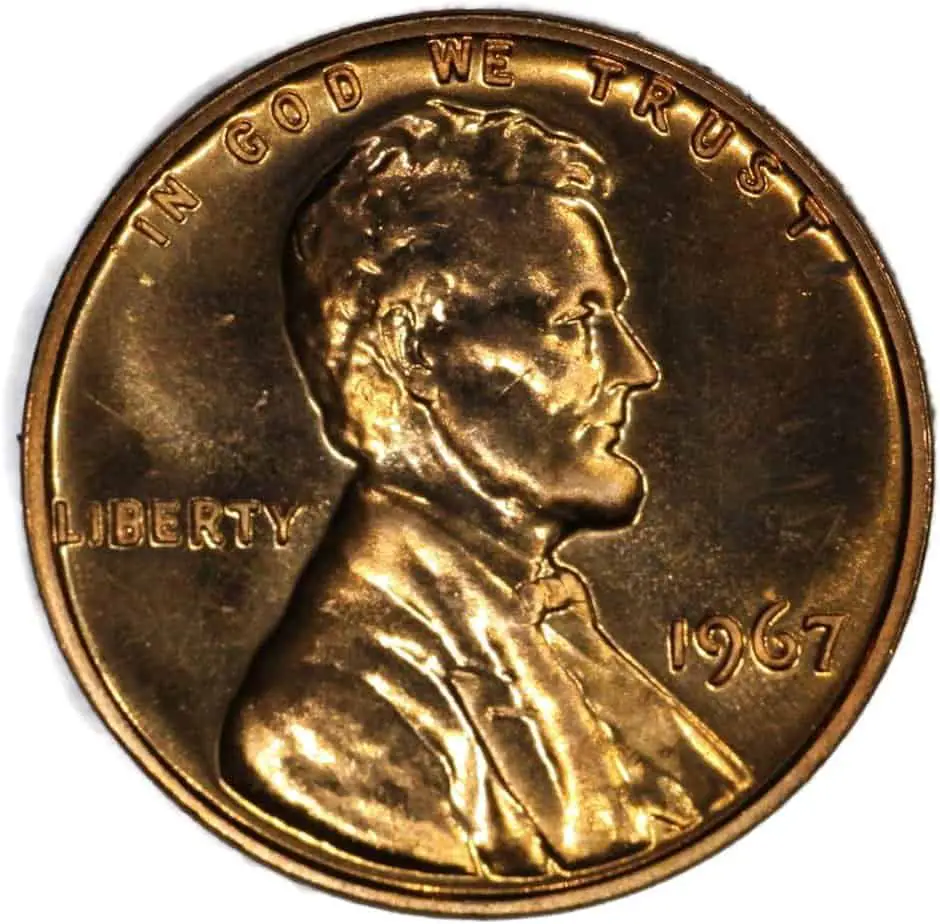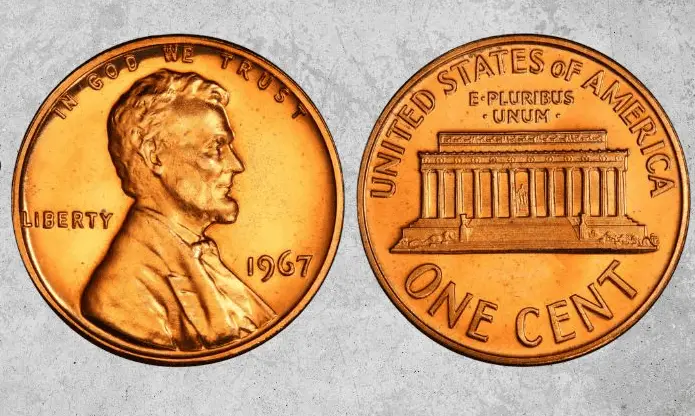Table of Contents
In the years leading up to decimalization, authorities produced 1967 pennies. Although the decimalization of the currency was decided in 1966, large pennies had to be minted before they became outdated. As a result, all pennies struck between 1967 and D-Day were stamped with 1967. It was done to prevent stockpiling by those filled with nostalgia for money that would soon be gone for good.
Only a few thousand of these pennies were ever in circulation before authorities pulled them from circulation. There are a lot of 1967 pennies that are still in mint condition because of this. Britannia is shown on the reverse of the 1967 British penny, sitting right-facing and grasping a trident. The cross of Saint George lies in her other hand. An exergue below the shield has a lighthouse and the date, with ‘ONE’ and ‘PENNY’ inscriptions in the fields. In this post, you will acknowledge everything about 1967 Penny.

How Much is a 1967 Penny Worth?
An uncirculated 1967 Penny is valued between $0.10 and $0.20. The most expensive 1967 penny was graded by the Professional Coin Grading Service (PCGS). A high-quality MS67RD grade 1967 penny was sold for $4,945 at a public auction in 2008!
With a total mintage of 3,048,667,100, the 1967 Lincoln Memorial cent is frequent. Yes, you got it right. Moreover, there are three billion people. If authorities created so many 1967 pennies, why would they all have a higher value than their face value? These antique pennies have a bronze composition of 95% copper and 5% zinc.

Because of the dramatic rise in copper’s price over the past several years, the copper content of a 1967 penny is now worth roughly two cents more than the coin’s face value. So even if we’re not talking about $50 or $100 coins, a coin worth at least two times its face value is something to watch for. It’s worth around 2 cents for a worn 1967 penny but 10 to 20 cents for an uncirculated coin from that year.
What is the Value of a 1967 Penny With no Mint Mark?
A 1967 penny with no mint mark MS-63RB grade is worth roughly $0.20 in uncirculated condition. A high-quality MS-65RD grade 1967 Penny is worth $0.50.
There isn’t much to be had in 1967 Lincoln pennies. However, uncirculated versions can command a premium price. You can find a lot of information here regarding one-cent coins. The 1967 cent was struck without a mint mark in the United States. Therefore, authorities produced no other penny series in this year’s mintage. With an MS-63RB grade, the 1967 cent without a mint mark is valued at around $0.20 in uncirculated conditions.
MS-65RD coins are worth around $0.50 in uncirculated conditions. MS-63RB choice uncirculated has some flaws or contact marks in the central focus regions. Therefore, it is possible that the coin’s luster will not be as noticeable. The hue is dark reddish-brown. Uncirculated, the MS-65RD gem has a high shine and visual appeal. There may be a few faint touch traces, but they are hardly perceptible. The predominant hue here is crimson.
One of the most often asked queries concerns coins that lack a mintmark. The Philadelphia Mint has produced millions of coins with no mintmarks. Unfortunately, due to the high mintage of this essential coin-minting operation, it is usual and seldom adds value to the coin.
A coin that lacks a mintmark because it was accidentally omitted instead of deliberately may be nonetheless valuable. A No S Proof coin in your family’s proof collection will help you get the best price possible by putting it in front of a worldwide audience of coin enthusiasts at Heritage Auctions. Although many coins without a mintmark are widespread, a No S Proof Coin from a Proof Set is rare.
What Makes the 1967 Lincoln Penny so Valuable?
The 1967 value is precious because this Penny consists of a bronze composition of 95% copper and 5% zinc. As a result, copper’s value has skyrocketed in recent years. As of the time, a 1967 penny’s copper content is worth double the coin’s face value over $2.
The U.S. Mint made unique Mint Sets in 1967, a unique type of coin collector’s item (SMS). Five coins were included in the 1967 Special Mint Set, including the SMS cent from 1967. The 1967 nickel, dime, quarter, and half dollar were all reissued with the same design. Even though these 1967 Lincoln pennies are copper, their distinctive gloss makes them more valuable than regular pennies.
The U.S. Mint produced 1,863,344 SMS sets in 1967, so Authorities produced only 1,863,344 1967 SMS pennies. The value of an ordinary SMS penny from 1967 is between 50 cents and $1. Therefore, for $5,581.25 at an auction in 2014, a 1967 SMS-cent-rated SP68RDDCAM by the Professional Coin Grading Service was sold.
How Much is a Dime from 1967 Worth?
A 1967 Roosevelt Dime is worth $0.10, while a high-quality MS+ Certified Roosevelt Dime is worth $7. The value of the Roosevelt Dime depends on the quality of certification.
All three mints were involved in the Roosevelt Dime series’ minting process. In 1967, the Roosevelt Dime was exclusively minted in Philadelphia; no coins were struck in Denver or San Francisco. The Philadelphia Mint was mandated to make 2,244,007,000 Roosevelt Dimes for that year. The Roosevelt Dime was struck by just one branch of the U.S. Mint for the first time.
Nickel and copper comprise about 75% of the 1967 Roosevelt Dime’s composition after the 1964 removal of silver. It produced a diameter of 17.9 mm and a weight of 2.27 grams. Many uncirculated Roosevelt Dimes from the post-1964 era still exist because of the massive mintage of these coins. Because of this, only the highest-quality Uncirculated coins are worth more than their face values. It’s important to know what to look for when grading Uncirculated coins because they’re more difficult to grade.
Most contemporary coins aren’t worth much for conventional coin collectors because they’re so ubiquitous. All grades lower than MS-63 are worthless since they may still be regularly discovered in most people’s pockets. Sadly, the majority of specimens will be in a state below MS-60. At roughly $0.50, MS-63 instances are available, and at $1, MS-65 is the most expensive one you can purchase.
MS-67 has a price of $18 for a two-point gain. Despite its rarity, even the most highly graded MS-68 1967 Roosevelt Dime is worth $400. Even if more individuals start collecting, Roosevelt Dimes or the supply diminishes. Prices won’t see much of a resurgence in the future years. No matter how you look at it, the 1967 Roosevelt Dime is a low-cost coin you may pick up by looking in your wallet.
What Makes a 1967 Dime Rare?
The United States Mint produced the 1967-P Roosevelt Dime. The 1967 Dime is rare due to its composition; the exterior layer is clad with copper and nickel, and the 1967 Dime center is copper.
The Roosevelt dime, or ten-cent Piece, is the current United States dime. After Franklin D. Roosevelt died in 1945, the United States Mint approved the production of this coin, which has his image on the obverse. As a member of the March of Dimes movement, Roosevelt was afflicted with polio. The Mint replaced the Mercury dime without legislative approval because of the ten-cent coin. The Commission of Fine Arts often criticized Chief Engraver John R. Shinnok for his model replicas. The currency was put into circulation in January 1946 after changing its original design.
Since its inception, the Roosevelt dime has been produced in considerable quantities. Shinnok’s design has not significantly changed since 1965 when the Mint switched from striking the coin in silver to the base metal. However, the dime isn’t as sought after by coin collectors as other current U.S. coins since it lacks special dates or silver content.
Unless anything unusual happens, these coins are worth exactly what they’re advertised. “Liberty, In God We Trust, and the date, together with the designers’ JS initials,” reads the coin’s obverse. The inscription “United States of America, E Pluribus Unum, One Dime” appears on the coin’s reverse. FDR is seen on the coin’s front, while the reverse has a torch in the middle surrounded by two branches in the background.
What is the Error on 1967 Penny?
There were two errors on the 1967 Penny: 1967 Double Die Penny Die Cracks & Die Breaks On 1967 Penny. These 1967 errors eventually increased the penny’s value.
But some pretty fascinating (and collectible) 1967 doubled-die pennies exhibit modest doubling, so there are still a few out there. Almost all doubles are in the letters and date, so they’re hard to miss. The value of a 1967 penny with a twofold die defect can range from $20 to $50 or even more. It depends on the size of the error and the demand from collectors specializing in these particular pieces.
During the last stages of the coin die’s life, wear and strain can cause cracks and breaks to form. They appear as raised lines or bumps on the struck coin and are called die breaks or cracks by coin collectors. Depending on the size and location of the die break, these mistakes might cost anywhere from $5 to $25. Also, the type of die crack must be taken into account. Another highly sought-after item is a die-cut, which may sell for over $150.
Conclusion
We hope you have acknowledged everything about the 1967 Penny. There are no dissenters in the values supplied here, and they are based only on what a competent coin dealer could sell a piece for in a particular grade. For ‘indication only,’ they are to be utilized. As a layperson, you may expect to obtain a better deal at an auction than at a dealer’s wholesale pricing. If you have something in high demand, your chances of success increase.
To avoid disappointment, it is best to remain cautious about your expectations. You are wishing you the best of success in your endeavors!
If you like bills and coins, you should learn more about Gold and Silver IRAs. You can protect your retirement fund if you invest in precious metals. Investors with gold IRAs can hold physical metals such as bullion or coins. Get a free pdf about Gold IRA.
GET GOLD IRA GUIDE
























